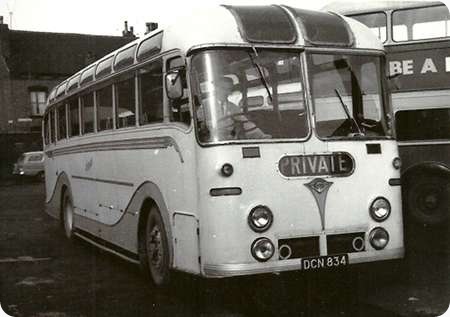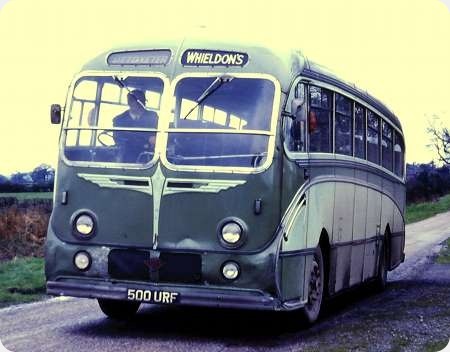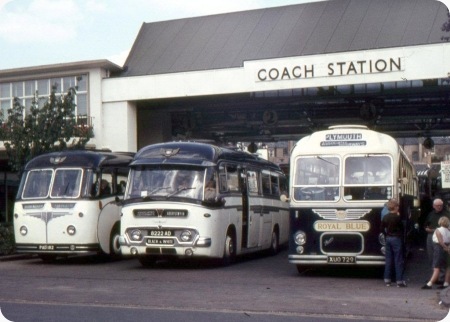
Copyright John Boylett
Samuel Ledgard
1954
Guy Arab LUF
Picktree C35F
DCN 834 was a Guy Arab LUF (chassis number 72143) with a Gardner 6HLW engine, bodied with a Picktree
Continental C35F body.
Picktree were based at Bensham in Gateshead, near the Northern General
headquarters, who had a financial stake in Picktree, these coaches being the last PSVs built by this
concern before they turned over to the construction of commercial vehicles.
834 was part of a
batch of 13 new to the Northern General Transport Company on 1st June 1954, and had fleet number 1534.
These vehicles had bold styling and had all the refinements required to undertake their principle
duties of carrying 35 passengers in comfort on Continental Tours.
During their final days with
Northern they undertook local tours to seaside resorts and on local Church and Club Private Hires,
before being withdrawn in September 1962 and sold to W. North of Sherburn, who took all 13.
A
total of 8* were bought by Ledgards, and taken in to stock in January 1963, these being DCN 831/ 834 -
840.
North’s put them through the MoT Certificate of Fitness test, before delivery to Ledgards,
and obtained ‘tickets’ for 5 years for them.
They were painted by Ledgards at Armley Depot
and all had entered service from there by April 1963.
The coach livery at that time consisted of
black roof, cream window surrounds, black wings, and blue panel work, with cream wheels.
The
final coach livery introduced by February 1964, was sky blue for the wings and window surrounds, with
ivory panels, 834, along with 839 were the first to be released in these new colours, as shown in the
picture.
The picture is taken on the roof of the Armley garage, where so many of Ledgard’s
vehicles ended their lives.
Does anybody know the name of the Driver?
834 was withdrawn in
April 1968 and went back to W. North (Dealer) at Sherburn, from where it was sold, along with 835/6/7 to
Minster Homes (Contractor) in May 1968 for use as site offices.
*DCN 832 was additionally bought
for spares from North’s (via Woods Coaches of Pollington, near Goole), in March 1966, and was dismantled
on Armley garage roof, the remains going to Jackson (Bradford) for scrap in August 1967.
A
picture of Northern General 1532 can be seen at this link.
For anybody interested in wanting to find out more about the
History and Fleet of Samuel Ledgard they should read the book Samuel Ledgard Beer and Blue Buses by Don
Bate. ISBN 095288499.
Photograph and Copy contributed by Stephen Howarth
18/08/13 - 06:40
Is the driver really Chris Youhill?
Joe
18/08/13 - 12:08
No Joe - that’s not me. We only had DCN 831 at Otley depot. However, now you
mention my good friend Don’s book, there is a picture of me as a young conductor at the bottom of
the front cover - this was as a token of appreciation for my assistance with photo captions and
information on aspects of the operations side of the Company.
Chris Youhill
20/08/13 - 18:57
In the 50’s and 60’s, Northern General had a booking Office in Pilgrim Street
Newcastle, which was just around the corner from Worswick Street Bus Station. Anyway, I remember
that in the window of the shop they had a model of one of these in a glass case. I don’t know what
the scale was, but to a young boy of about eight or nine it looked enormous. From other makers
models I’ve seen, I would guess it would have probably been an inch to the foot, so about 30ins
long. I wonder what happened to it?
Ronnie Hoye
10/11/14 - 06:48
There are some pictures of Ledgard buses, including one of these Guys, on the
following site of Marc Parry (with whom I once worked at LCBS); scroll down a little from the top of
the first page:- www.flickr.com/photos/
Roger Cox
12/02/15 - 06:35
The driver of DCN 834 is me John Jackson, taken in August 1967.
John Jackson
12/02/15 - 12:15
Nice to see you "in print" JJ - if only the good old firm was still
around - the happiest days of my PSV career without a doubt !!
Chris Youhill
13/02/15 - 06:18
Chris, what made Ledgard’s such a good place to work? Were the T&Cs better
than WYRCC? - I know from my time in Cambridge that Premier apparently had better terms and
conditions than ECOC. Geography may have played a part, but surely Armley-based drivers could have
found better terms with LCT up the road at Bramley or in the City Centre at Sovereign Street? But
then again why drive for Ribble out of Bolton or Hebble, full-stop, when corporation operations in
the same town(s) offered better salaries . . .? Did variety of work, or the opportunity of
"top-link" work (and associated tips) play a part?
Philip Rushworth
22/02/15 - 16:26
Well Philip, any answer to your question is bound to be complex and to vary
between individual employees of every grade. So perhaps its best put as a "list."
T
& Cs - very favourable indeed, and the wage rates were good and generous. When I started there were
no sick pay or pension schemes but many other advantages.
Duties - comprehensive and
interesting with none of the soul destroying "one road and the same mate for ever" system
of many of the municipalise and group concerns.
We had five depots, each with its own rota
and ro9ute systems derived from its origin - built by SL or acquired. Well to be exact four depots,
as Ilkley was a "running shed" administered totally from the larger Otley one - a seven
week rota of local folks from nearby, while Otley had a twenty week rota - with a little twist !!
All twenty drivers moved forward week by week while seventeen of the conductors moved "up the
sheet" - the other three conductors were to all intents and purposes always on the Otley local
cross town service from Bradford Road (Golf House) to Newall Estate - they all liked it and it
suited them with their Ultimate ticket machines !!
Variety of work - plenty as most duties
involved working on more than one route daily - not all, but most - and the mix of routes was
considerable, varying widely between very very busy town services and almost always hectic longer
interurban ones. Running times were generally pretty tight, especially with traditional live
transmission vehicles and much hilly terrain with frequent stops and, despite the oft heard modern
saying "Ah but there wasn’t the traffic around then" there was more than enough to contend
with.
Rolling stock - now here was the real appeal, especially to anyone with even a trace of
interest and enthusiasm. The mix was incredible, with representatives new and previously owned, of a
wide array of chassis and body makes, ages and origins - and mainly distributed seemingly
"willy nilly" around the depots. Larger concerns might view this as unsatisfactory and
often had rigid allocation policies - fair enough if it suited them. Despite this way of working at
Ledgard’s maintenance by skilled and dedicated staff was extremely good indeed - most of the heavy
work being carried out at Otley and the huge Armley Leeds premises - resulting in the virtually 100%
reliable service at all times and in all conditions which the Public have never enjoyed since and a
"straw poll" on the streets would certainly confirm this. The local press after the
October 1967 SL demise was full of justifiable venom against the new regime(s).
Its often
forgotten, or perhaps not even known by younger people, that until Samuel himself died in April 1952
all vehicle purchases since 1912 had been brand new, other than those acquired with taken over
Firms. When the necessity then arose for multiple reasons, Death duties chiefly, to buy second hand
the Executors chose carefully and wisely and only rarely bought a lame duck or, as is the amusing
term oft used in the motor trade, a "dog."
Chris Youhill
23/02/15 - 07:30
Chris, thanks for that reply. So was Yeadon a "full" depot then? I’d
always assumed it was an Otley dormy shed, like Ilkley.
Samuel Ledgard is always presented as
the archetypical shrewd Yorkshire businessman . . . but he wasn’t so shrewd as to take the necessary
steps to protect his main business interests in the event of his death. That being said he did die
at a relatively young age and might not have thought it necessary at that time - and I suppose there
are disadvantages in forming limited liability companies.
Philip Rushworth
23/02/15 - 07:31
Chris Y - You certainly have a nice and relaxed writing style, which is easy
to read, informative, and easy to understand.
I must admit (and I am sure others will agree)
that I read every one of your contributions to this site because they are so full of knowledge and
interest, not just on Samuel Ledgard, as above, but on all aspects of PSV (none of that PCV stuff on
here) operations, and history.
Long may you continue to contribute and keep me, at least,
educated and informed with your wealth of knowledge.
For those on here who want to know more
about the History of Samuel Ledgard then I would recommend the book, BEER AND BLUE BUSES - by DON
BATE (ISBN: 9780952388494), if you are able to find one for sale. Mr Y has contributed, and, (not
for the faint hearted) there is even a picture of him on the front cover.
Stephen Howarth
23/02/15 - 08:45
Indeed Philip, Yeadon was to all intents and purposes a full independent
depot, and was referred to right up to the end in 1967 as "The Moorfield" - officially and
among the staff and passengers. The name was of course that of the Moorfield Bus Company taken over
by SL in 1934. All essential maintenance and quite heavy intermediate work was carried out there,
but major overhauls and recertification were done at Otley. or Armley. The crews at Yeadon, about
fourteen if I recall correctly, were a lively set of loveable individual characters - no one more so
than "the Reverend Candler" who very sadly passed away en route for a late turn aged only
in his early forties. Only very occasionally did Yeadon have to exchange staff with Otley in extreme
circumstances - like my Siberian Monday rest day on a split turn with the aforementioned Reverend.
Otherwise on Summer Sundays it was routine for Moorfield staff and buses, if available, to be sent
on standby to Otley, where literally huge crowds of Leeds (mainly) and Bradford city dwellers needed
taking home after a nice day out - sometimes the queues were still large at nine and ten on Sunday
evenings, and all were cleared without fail - such was the reliable SL service.
Stephen - thank you indeed for your kind remarks which leave me blushing here.
I do find it easy to write about the subject, and I enjoy keeping the fading history of the old
Firm, and the earlier industry in general, alive where I can. I had to chuckle at your warning to
the unwary that my picture (late 1957) on the cover of Don’s book is not for the fainthearted - I’m
afraid that a current view if published would have the A & E Departments on overtime !! Don was only
saying last evening that its around ten years since the book was published - time flies.
Chris Youhill
23/02/15 - 14:28
There are currently 3 copies available on ABE Books website (other book
searches are available) they range between £30 and £40 +p&p
John Lomas
24/02/15 - 06:14
I’m surprised no one has picked up on Philip Rushworth’s comment that Samuel
Ledgard died relatively young.
Born in 1874 and dying in 1952 that made him 78 years of age.
I would have thought that a "good innings" for that era.
Eric Bawden
24/02/15 - 06:15
Six in total John, from the three outlets
Chris Youhill
27/02/15 - 06:59
Eric, you are right: I didn’t check my facts - in my defence, my books are
currently packed away - and I’d confused the date at which he became licensee of The Nelson . . .
which would have made him about ?14 when he put his first char-a-banc on the road! But, it just
serves to underline my point: he’d have been 72 when Clement Atlee’s Labour government took power -
over the next few years he’d have had plenty time to see which way the wind was blowing on Capital
Transfer Tax . . . and yet he did nothing to protect his businesses, despite his age.
Philip Rushworth



